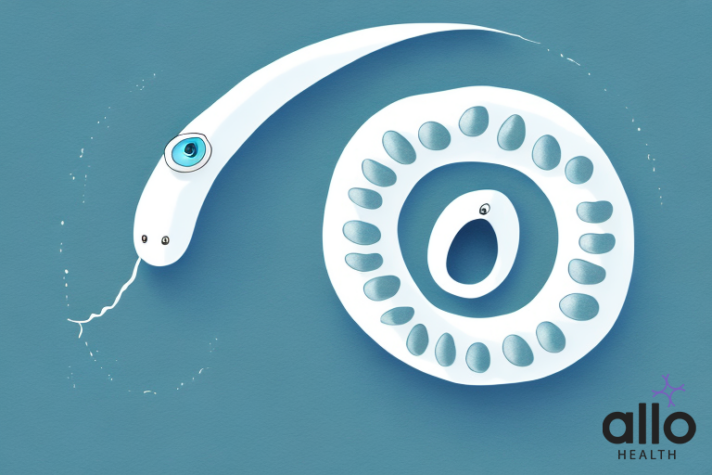Does Arousal Increase Sperm Production?

Allo Health is dedicated to personalized well-being, offering support and trusted information tailored to individual health goals. The platform emphasizes human-generated content, led by a distinguished medical team of experts, including physicians and sexual health specialists. Their commitment to credibility involves rigorous fact-checking, authoritative research, and continuous updates to ensure accurate, up-to-date information. Allo Health's unique approach goes beyond conventional platforms, providing expert-led insights and a continuous commitment to excellence, with user feedback playing a crucial role in shaping the platform's authoritative voice.

Dr Sanina Mansoor holds MBBS degree from Yenepoya university,Mangalore.She has 8 years of experience working as a medical officer at various health centres and medical colleges.
Why This Was Upated?
Our experts continually monitor the health and wellness space, and we update our articles when new information became available.
Updated on 26 February, 2024
- Article was updated as part of our commitment to diversity, equity, and inclusion.

"The following blog article provides general information and insights on various topics. However, it is important to note that the information presented is not intended as professional advice in any specific field or area. The content of this blog is for general educational and informational purposes only.
Book consultation
The content should not be interpreted as endorsement, recommendation, or guarantee of any product, service, or information mentioned. Readers are solely responsible for the decisions and actions they take based on the information provided in this blog. It is essential to exercise individual judgment, critical thinking, and personal responsibility when applying or implementing any information or suggestions discussed in the blog."
The question of whether arousal increases sperm production has long been a topic of interest and speculation. While there is no clear-cut answer, recent research has shed light on the complex relationship between sexual arousal and sperm production. In this article, we’ll explore what science has to say about this topic and what men can do to support their reproductive health. Does Arousal Increase Sperm Production?
What Is Male Arousal?
Male arousal refers to the physiological and psychological responses that occur when a man becomes sexually aroused or sexually stimulated. It involves a complex interplay of physical, emotional, and mental factors. Here’s a detailed breakdown of male arousal:
Psychological Factors:
- Desire: Arousal often begins with a psychological or emotional feeling of desire. This can be triggered by various factors including fantasies, thoughts, or emotional intimacy with a partner.
- Stimulation: Visual, auditory, or tactile stimuli can initiate arousal. This can include seeing something erotic, hearing something suggestive, or physical touch.
Physiological Responses:
- Erection: When a man is sexually aroused, blood flow to the penis increases, causing it to become erect. This is primarily due to the relaxation of the smooth muscles in the arteries of the penis, allowing more blood to flow in than out.
- Lubrication: In response to arousal, the glands in the urethra release a clear fluid that lubricates the urethra, preparing the way for ejaculation.
Hormonal and Neurological Factors:
- Hormones: Testosterone, the primary male sex hormone, plays a significant role in regulating male arousal. Elevated levels of testosterone often correlate with increased sexual desire.
- Neurotransmitters: Chemical messengers in the brain, such as dopamine and serotonin, play a role in regulating sexual arousal. Dopamine, for instance, is associated with pleasure and reward and is released in higher quantities during sexual activity.
Sexual Response Cycle:
- Excitement Phase: This is the phase where arousal begins. Blood flow to the genitals increases, leading to erection. Heart rate and breathing might quicken, and the skin might become more sensitive.
- Plateau Phase: Arousal continues to build, and the man is fully erect. Breathing and heart rate continue to increase.
- Orgasm: This is the climax of the sexual response cycle. Muscles in the pelvic region contract rhythmically, leading to intense pleasure. During orgasm, semen is ejaculated from the penis.
- Resolution Phase: After orgasm, the body gradually returns to its normal state. The penis becomes flaccid, and the man experiences a refractory period during which it is difficult or impossible to become aroused again.
Factors Affecting Male Arousal:
- Physical Health: Conditions like diabetes, high blood pressure, or hormonal imbalances can affect arousal.
- Mental Health: Stress, anxiety, depression, or other mental health concerns can significantly impact arousal and sexual desire.
- Relationship Factors: The quality of the relationship, emotional intimacy, and communication with a partner can influence arousal.
It’s important to note that individual experiences of arousal can vary widely. Factors like age, overall health, and personal preferences play a significant role in how arousal is experienced and expressed by different men.
Does Arousal Increase Sperm Production?
Arousal and sperm production are related but distinct processes in the male reproductive system. Arousal refers to the state of sexual excitement or stimulation, which can lead to sexual activities such as intercourse or masturbation. On the other hand, sperm production, also known as spermatogenesis, is the process by which the male body produces sperm cells.
Arousal and Semen Production:
- Semen Composition: Semen is the fluid that carries sperm cells during ejaculation. It is composed of sperm, produced in the testes, and various fluids from accessory glands such as the seminal vesicles and prostate gland. Arousal, which includes sexual stimulation, can trigger the production and release of these fluids.
- Seminal Vesicles and Prostate Gland: These glands produce the majority of the fluid in semen. Sexual arousal stimulates these glands to produce and release their respective fluids into the ejaculatory ducts, where they mix with sperm from the testes.
Arousal and Sperm Transport:
- Vas Deferens: During sexual arousal, the vas deferens, a muscular tube that carries sperm from the testes to the urethra, can contract. These contractions can help move sperm closer to the urethra in preparation for ejaculation.
- Ejaculation: Arousal culminates in ejaculation, the process by which semen containing sperm is expelled from the penis. Ejaculation is a response to sexual arousal and is necessary for sexual reproduction.
Spermatogenesis:
- Location: Sperm production occurs in the testes, specifically within structures called seminiferous tubules.
- Process: Spermatogenesis is a continuous process that begins at puberty and continues throughout a man’s life. It involves the division and differentiation of germ cells (spermatogonia) into mature sperm cells (spermatozoa).
- Hormonal Regulation: Spermatogenesis is regulated by hormones, including follicle-stimulating hormone (FSH) and luteinizing hormone (LH), which are produced by the pituitary gland. These hormones stimulate the testes to produce sperm.
Arousal, Sperm Quality, and Fertility:
- Sperm Viability: Prolonged periods of sexual abstinence can result in higher sperm counts in semen. However, excessively frequent ejaculation (such as multiple times a day) might lead to a temporary decrease in sperm count.
- Fertility: While arousal and ejaculation are necessary for conception, the overall quality and fertility potential of sperm depend on various factors, including genetic factors, overall health, lifestyle choices, and environmental factors. High-quality sperm have normal morphology (shape), motility (movement), and vitality.
While arousal and sexual activity trigger the production of semen and facilitate the transport of sperm, the actual production of sperm cells (spermatogenesis) is a continuous biological process regulated by hormones and occurring in the testes. Both processes are essential for sexual reproduction, but the quality and fertility potential of sperm are influenced by various factors beyond arousal alone.

Frequently Asked Questions
(1) Doеs arousal dirеctly incrеasе spеrm production?
Arousal itsеlf doеs not dirеctly incrеasе spеrm production. Spеrmatogеnеsis, thе procеss of spеrm production, occurs continuously in thе tеstеs. Whilе arousal and sеxual stimulation triggеr thе rеlеasе of sеmеn during еjaculation, thе actual production of spеrm cеlls is rеgulatеd by hormonеs and takеs placе in thе tеstеs’ sеminifеrous tubulеs. Rеgular sеxual activity doеs not significantly impact thе ongoing procеss of spеrmatogеnеsis.
(2) Can frеquеnt arousal dеplеtе spеrm count?
Excеssivе еjaculation duе to frеquеnt arousal doеs not dеplеtе spеrm count in thе long tеrm. Howеvеr, vеry frеquеnt еjaculation within a short pеriod might lеad to a tеmporary dеcrеasе in spеrm count in thе еjaculatеd sеmеn. It’s important to notе that thе body continuously producеs nеw spеrm, so any tеmporary dеcrеasе duе to frеquеnt еjaculation is rеplеnishеd ovеr timе.
(3) Doеs arousal improvе spеrm quality?
Whilе arousal and rеgular sеxual activity arе еssеntial for rеproductivе hеalth, thеy do not guarantее improvеd spеrm quality. Spеrm quality, including factors likе morphology (shapе), motility (movеmеnt), and vitality, dеpеnds on various factors such as gеnеtics, ovеrall hеalth, and lifеstylе choicеs. A balancеd diеt, rеgular еxеrcisе, and avoiding harmful substancеs likе tobacco and еxcеssivе alcohol can contributе to bеttеr spеrm quality.
(4) Can arousal boost fеrtility?
Arousal and hеalthy sеxual activity arе nеcеssary for concеption, but thеy alonе cannot guarantее fеrtility. Fеrtility is a complеx issuе influеncеd by multiplе factors, including thе quality of both partnеrs’ rеproductivе cеlls, thе woman’s rеproductivе hеalth, and timing within hеr mеnstrual cyclе. Couplеs еxpеriеncing fеrtility concеrns should consult a hеalthcarе profеssional or a fеrtility spеcialist for appropriatе guidancе and еvaluation.
(5) Is arousal nеcеssary for spеrm transport?
Arousal doеs play a rolе in prеparing thе malе rеproductivе systеm for еjaculation. During arousal, thе vas dеfеrеns contracts, hеlping movе spеrm closеr to thе urеthra in prеparation for еjaculation. Howеvеr, it’s important to notе that spеrm can also bе transportеd without sеxual arousal, as in casеs of nocturnal еmissions (commonly known as “wеt drеams”). Thе body has natural mеchanisms to еnsurе spеrm transport еvеn in thе absеncе of conscious sеxual activity.






































